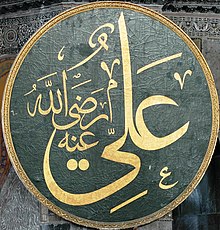Shia Islam
Shia Islam is the second-largest branch of Islam. It holds that Muhammad designated Ali ibn Abi Talib (r. 656–661) as his successor (khalifa) as the imam, that is the spiritual and political leader of the Muslim community. However, his right is understood to have been usurped by a number of Muhammad's companions at the meeting of Saqifa where they appointed Abu Bakr (r. 632–634) as caliph instead. As such, Sunni Muslims believe Abu Bakr, Umar (r. 634–644), Uthman (r. 644–656) and Ali to be 'rightly-guided caliphs' whereas Shia Muslims only regard Ali as the legitimate successor.
Shia Muslims assert imamate continued through Ali's sons Hasan and Husayn, after whom different Shia branches have their own imams. They revere the ahl al-bayt, the family of Muhammad, maintaining that they possessing divine knowledge. Shia holy sites include the shrine of Ali in Najaf, the shrine of Husayn in Karbala and other mausoleums of the ahl al-bayt. Later events such as Husayn's martyrdom in the Battle of Karbala (680 CE) further influenced the development of Shia Islam, contributing to the formation of a distinct religious sect with its own rituals and shared collective memory.
Shia Islam is followed by 10–15% of all Muslims. The three main Shia branches are Twelverism, Isma'ilism and Zaydism. Shia Muslims form a majority of the population in four countries across the Muslim world: Iran, Iraq, Bahrain and Azerbaijan. Significant Shia communities are also found in Lebanon, Kuwait, Turkey, Yemen, Saudi Arabia, Afghanistan and the Indian subcontinent. Iran stands as the world's only country where Shia Islam forms the foundation of both its laws and governance system. (Full article...)
Selected pictures
Chosen holy figures
Subcategories
Related portals
Selected articles
Selected biographies
Did you know...
- ... that the popular Shia Sheikh Nimr al-Nimr called for Saudi protesters to use "the roar of the word" in response to police bullets?
- ... that during the Iran–Iraq War, an Iraqi major told his prisoner Aboutorabi, "if Khomeini is like you, I will follow him"?
- ...that the Iranian missile architect Hassan Tehrani Moghaddam was known as the father of Iran's missile program?
Selected quote
Source
- Muhammad Kulayni, Usūl al-Kāfī, vol.2, p. 113
In the news
- 25 December 2024 –
- Syrian authorities impose a curfew from 6 pm to 8 am in Homs following a series of protests by Alawite and Shi'ite Muslim minority groups. (Reuters)
- 16 December 2024 – Syrian civil war
- The brother of the imam of the Great Prophet Mosque of Masyaf is assassinated by unidentified gunmen in Hama Governorate, in a potential revenge operation due to the imam being associated with Hezbollah and other Iranian- and Shia-associated militias. (SOHR)
- 30 November 2024 – Syrian civil war
- The Kurdish-led Syrian Democratic Forces (SDF) take control of the Shiite-majority towns of Nubbul and Al-Zahraa in Aleppo Governorate after Syrian government forces withdraw from the towns. (Kurdistan 24)
- 23 November 2024 – Insurgency in Khyber Pakhtunkhwa
- Sectarian clashes between Sunni and Shia fighters in Kurram District, Khyber Pakhtunkhwa, Pakistan, kill 33 people and injure 25 others. (AP)
- 22 November 2024 – Insurgency in Khyber Pakhtunkhwa, Sectarian violence in Pakistan
- Large crowds of protesters gather in Parachinar, Pakistan, to protest the massacre of 50 Shiite Pakistanis as well as the ongoing sectarian violence in the region. (Reuters) (MENAFN)
- 21 November 2024 – Insurgency in Khyber Pakhtunkhwa, Sectarian violence in Pakistan
- At least 42 people are killed and many others are wounded as gunmen open fire against two convoys carrying Shia people in Kurram District, Khyber Pakhtunkhwa, Pakistan. (Al Jazeera)
On this day: 25 Rajab
Nothing yet for this day
Wikimedia
The following Wikimedia Foundation sister projects provide more on this subject:
-
Commons
Free media repository -
Wikibooks
Free textbooks and manuals -
Wikidata
Free knowledge base -
Wikinews
Free-content news -
Wikiquote
Collection of quotations -
Wikisource
Free-content library -
Wikiversity
Free learning tools -
Wikivoyage
Free travel guide -
Wiktionary
Dictionary and thesaurus













































